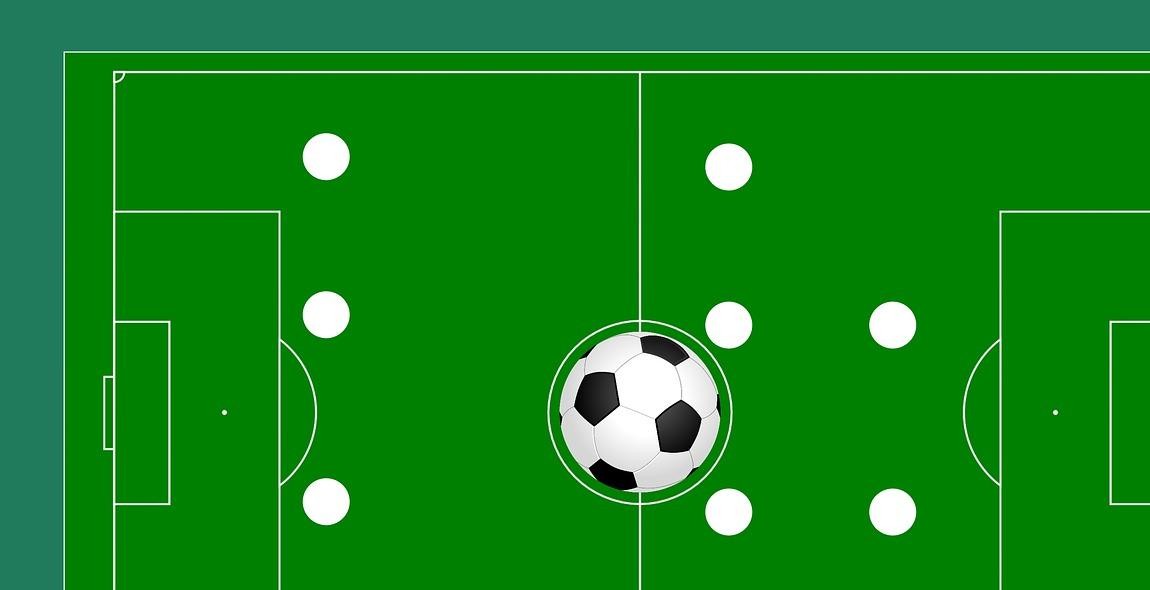How to Develop Soccer Strategy and Tactics: Formations and Game Plans for Success
Soccer is a sport that requires a combination of physical ability, technical skills, and strategic thinking. A successful soccer team needs more than just individual talent; it needs a cohesive game plan that maximizes the strengths of each player and minimizes their weaknesses. Developing a soccer strategy and tactics is an essential part of any team’s success.
As a professional soccer player and coach with over 10 years of experience, I have learned the importance of developing a game plan that suits the team’s strengths and weaknesses. In this article, I will share my insights on how to develop a soccer strategy and tactics that will help your team succeed.
The Importance of Formations
Formations are a crucial aspect of soccer tactics. They determine the positions of players on the field and how they interact with each other. There are many different formations to choose from, each with its own strengths and weaknesses. In this article, we will explore the most popular formations and how to choose the right one for your team.
Developing a Game Plan
Once you have chosen a formation, the next step is to develop a game plan. A game plan outlines the team’s objectives and how they plan to achieve them. It includes strategies for attacking, defending, and transitioning between the two. In this article, we will discuss how to develop a game plan that maximizes your team’s strengths and exploits your opponents’ weaknesses.
Conclusion
Developing a soccer strategy and tactics is an ongoing process that requires constant assessment and adjustment. By following the tips and strategies outlined in this article, you can create a game plan that will help your team succeed on the field.

Understanding the Basics of Soccer Strategy
Soccer is a game of strategy and tactics, and understanding the basics of both is crucial to achieving success on the field. There are two main types of soccer strategy: defensive and offensive.
Defensive Strategy
Defensive strategy is all about preventing the opposing team from scoring. A strong defense can make all the difference in a soccer game, and there are several different tactics that can be used to achieve this goal.
- Man-to-man marking: This involves assigning each defender to mark a specific player on the opposing team, making it more difficult for them to receive the ball and create scoring opportunities.
- Zonal marking: This involves dividing the field into zones and having each defender focus on protecting their assigned zone, rather than marking a specific player.
- Offside trap: This involves the defenders moving up the field as a unit, catching the opposing team’s forwards in an offside position and preventing them from receiving the ball.
Offensive Strategy
Offensive strategy is all about creating scoring opportunities and putting pressure on the opposing team’s defense. There are several different tactics that can be used to achieve this goal.
- Formations: Different formations can be used to create different types of scoring opportunities. For example, a 4-3-3 formation is often used to create a lot of attacking pressure, while a 5-4-1 formation is often used to defend a lead.
- Passing: Good passing is crucial to creating scoring opportunities. Players need to be able to move the ball quickly and accurately, making it difficult for the opposing team to defend.
- Set pieces: Set pieces, such as corners and free kicks, can be used to create scoring opportunities. These require careful planning and execution, as the opposing team will be looking to defend against them.
| Defensive Strategy | Offensive Strategy |
|---|---|
| Man-to-man marking | Formations |
| Zonal marking | Passing |
| Offside trap | Set pieces |

Choosing the Right Formation
One of the most crucial decisions that a coach has to make when developing a soccer strategy is choosing the right formation. The formation determines the team’s shape, style of play, and overall game plan. Here are three popular formations that can help teams achieve success:
4-4-2 Formation
The 4-4-2 formation is one of the most commonly used formations in soccer. It consists of four defenders, four midfielders, and two forwards. This formation is well-balanced and provides a solid defensive structure while still allowing for attacking opportunities. The midfielders play a crucial role in this formation, as they must provide support both defensively and offensively. The two forwards must work together to create scoring chances.
4-3-3 Formation
The 4-3-3 formation is an attacking formation that consists of four defenders, three midfielders, and three forwards. This formation is ideal for teams that have strong attacking players. The three forwards work together to create scoring opportunities, while the three midfielders provide support and help maintain possession of the ball. However, this formation can leave the team vulnerable defensively, so it’s important to have strong defenders.
3-5-2 Formation
The 3-5-2 formation is a more attacking formation that consists of three defenders, five midfielders, and two forwards. This formation is ideal for teams that have strong midfielders who can control the game. The three defenders must be strong and disciplined to provide adequate defensive cover. The five midfielders work together to control possession and create scoring opportunities, while the two forwards must be clinical in front of goal.
| Formation | Strengths | Weaknesses |
|---|---|---|
| 4-4-2 | Well-balanced, solid defensive structure, attacking opportunities | Can be predictable, lacks width in attack |
| 4-3-3 | Strong attacking options, good possession play | Vulnerable defensively, relies heavily on midfielders |
| 3-5-2 | Strong midfield control, attacking options | Requires strong and disciplined defenders, can be vulnerable on the wings |
Ultimately, the choice of formation depends on the strengths and weaknesses of the team and the opposition. Coaches must carefully consider their options and make the best decision for their team to achieve success.

Developing a Game Plan
Developing a game plan is crucial for any soccer team looking to achieve success. A game plan outlines the team’s objectives and strategies for achieving them on the field. There are three key elements to consider when developing a game plan:
Analyzing the Opponent
The first step in developing a game plan is to analyze the opponent. This includes studying their strengths and weaknesses, as well as their playing style and tendencies. Coaches should gather as much information as possible on the opponent, including past performances, player statistics, and game footage. This information can be used to identify areas of weakness to exploit and areas of strength to avoid. With a thorough understanding of the opponent, coaches can create a game plan that maximizes their team’s chances of success.
Setting Team Objectives
Once the opponent has been analyzed, the next step is to set team objectives. These objectives should be specific and measurable, such as scoring a certain number of goals or maintaining possession for a certain percentage of the game. Objectives should be tailored to the opponent and should take into account the team’s strengths and weaknesses. By setting clear objectives, coaches can motivate players and help them focus on the task at hand.
Game Day Preparation
The final step in developing a game plan is game day preparation. This includes finalizing the team’s tactics and formations, as well as reviewing the opponent’s tendencies with the team. Coaches should also ensure that players are mentally and physically prepared for the game, including warming up properly and staying hydrated. By preparing thoroughly for game day, coaches can help their team perform at their best.
| Analyzing the Opponent | Setting Team Objectives | Game Day Preparation |
|---|---|---|
| Gather information on opponent’s strengths and weaknesses | Set specific and measurable team objectives | Finalize tactics and formations |
| Identify areas of weakness to exploit and areas of strength to avoid | Tailor objectives to opponent and team strengths/weaknesses | Review opponent’s tendencies with team |
| Use information to create a game plan that maximizes chances of success | Motivate players and help them focus on task at hand | Ensure players are mentally and physically prepared for game |

Executing the Plan on the Field
Developing a soccer strategy and tactics is only the first step towards achieving success on the field. The next step is to execute the plan effectively during the game. This requires communication and coordination among the players, as well as the ability to adjust to in-game situations.
Communication and Coordination
In order to execute the plan effectively, it is important for the players to communicate with each other throughout the game. This involves calling out instructions, providing feedback, and maintaining a constant flow of information between teammates. It is also essential for players to coordinate their movements and actions on the field, in order to maintain a cohesive team structure.
One effective way to improve communication and coordination is through regular training sessions and team-building exercises. This can help players to develop a better understanding of each other’s strengths and weaknesses, and to build trust and confidence in each other’s abilities.
Adjusting to In-Game Situations
Despite the best-laid plans, soccer games are often unpredictable, and teams need to be able to adjust to in-game situations as they arise. This requires a combination of tactical flexibility and mental agility, as players need to be able to think on their feet and adapt to changing circumstances.
One way to improve this ability is to develop a range of different game plans and formations, which can be adjusted depending on the opposition and the specific challenges that arise during the game. It is also important for players to remain calm and focused, even in high-pressure situations, and to maintain a positive attitude throughout the game.
| Key Takeaways |
|---|
| Effective execution of a soccer strategy and tactics requires communication and coordination among players, as well as the ability to adjust to in-game situations. |
| Regular training sessions and team-building exercises can help to improve communication and coordination among players. |
| Teams should develop a range of different game plans and formations, which can be adjusted depending on the opposition and the specific challenges that arise during the game. |
| Players should remain calm and focused, even in high-pressure situations, and maintain a positive attitude throughout the game. |

Conclusion
Developing a soccer strategy and tactics is an essential aspect of winning games and achieving success. It requires a thorough understanding of the game, the team’s strengths and weaknesses, and the opponent’s playing style. In this article, we have discussed the importance of formations and game plans in soccer and how to develop them.
Key Takeaways
- Choosing the right formation depends on the team’s strengths and weaknesses, the opponent’s playing style, and the game’s objectives.
- Game plans should be flexible and adaptable to changing situations during the match.
- Effective communication, teamwork, and practice are crucial for executing game plans successfully.
- Coaches should continually evaluate and adjust the team’s strategy and tactics based on performance and results.
Final Thoughts
Developing a successful soccer strategy and tactics is a continuous process that requires dedication, hard work, and a willingness to learn and adapt. By following the tips and guidelines outlined in this article and putting in the effort, coaches and players can create a winning game plan that leads to success on the field.
| Key Points | Action Items |
|---|---|
| Choose the right formation | Evaluate the team’s strengths and weaknesses and the opponent’s playing style |
| Create flexible game plans | Practice adapting to changing situations during the match |
| Communicate effectively | Encourage teamwork and collaboration |
| Evaluate and adjust | Continually assess the team’s performance and adjust the strategy and tactics accordingly |
